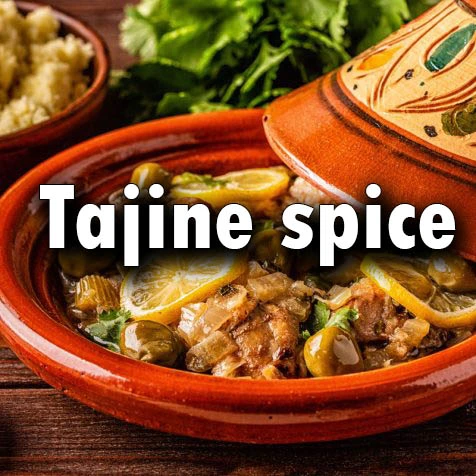How My Mother Taught Me to Cook the Perfect Moroccan Tagine -tajin spice
How My Mother Taught Me to Cook the Perfect Moroccan Tagin -tajin spice

I was surrounded by the comfortable sound of sizzling pots and the rich fragrances of spices while growing up in a lively Moroccan home. I adore eating, but there was one meal in particular that I would never attempt to prepare: Moroccan tagine. I had always trusted the professionals, like my mother, whose tagine was renowned. All of that changed one day when I made the decision to start learning. I had no idea that this adventure would bring me closer to my roots and my family in addition to a fantastic supper.
There is a video explaining the preparation method at the bottom of the article.
My story with tagin- tajin spice –
I got up on a lovely Saturday morning with a mission: I was going to master the tagine today. The aroma of paprika, coriander, and cumin was tantalizing my senses even before I saw it. Even though the kitchen was a familiar space, entering it today seemed like entering a another universe. I assembled all the components, sure that this would be simple. I had seen my mother succeed on numerous occasions, so how difficult could it really be?
The Struggle: Trying to Cook Tagin on My Own ( tajin spice )
My assurance soon gave way to bewilderment. Was it one or two teaspoons of cumin? Should I begin with the meat or the onions? It seemed as like I was missing a vital component of the puzzle. Nevertheless, I proceeded, adding ingredients to the saucepan and crossing my fingers. It was evident as the minutes went by that things weren’t going according to plan. The meat was rough, the veggies overdone, and the spices were overpowering. I had not succeeded. Hungering and frustrated, I recognized I needed assistance.
The Turning Point: Asking for My Mother’s Help To learn how to prepare a tagine – tajin spice
Although it was difficult to admit defeat, I swallowed my pride and cried out to my mother. She smiled knowingly as she walked into the kitchen, having undoubtedly expected this. Her tone was soothing and peaceful as she stated, “Let me show you how it’s done.” The sight of my mother in the kitchen was a comforting salve. Her confident and elegant movements were a result of years of training. I had a feeling this was going to be more than a recipe.
Learning from the Master: Step-by-Step Guide to Cooking Tagin – Tajin spice
Expanded Steps for Preparing the Tagine
Step 1: Choosing the Right Ingredients – Tajin spice
Early in the morning, my mother took me to the market and explained that choosing fresh, high-quality items is the first step in making a delicious tagine. She demonstrated for me how to choose firm, brilliantly colored veggies. She said, “You want the tomatoes ripe but not mushy, and the carrots crisp.” We then discussed spices, which are a crucial component of Moroccan cooking.
“Spices are the essence of our cuisine,” she remarked, picking out cinnamon, cumin, coriander, turmeric, and paprika with care. Every spice had a distinct function: cinnamon added a hint of sweetness, turmeric added color, and cumin for warmth. In addition, we purchased preserved lemons and green olives, which are traditional components that enhance the flavor of the tagine. She said, “And never use powdered garlic—always use fresh.”
Step 2: Preparing the Ingredients – tajin spice
Preparation resumed in the kitchen. In order to ensure consistent cooking, my mother showed me how to peel and slice the veggies into uniform pieces. “The secret is in the details,” she said, “make sure each piece is similar in size.” She then gave a demonstration on how to marinate meat. For this tagine, we utilized chicken, although traditional alternatives would also include lamb or beef.
The chicken pieces were put in a bowl with smashed garlic, ginger, salt, pepper, and a good pinch of our selected seasonings. Using her hands, she combined everything, rubbing the spices into the meat. She clarified, saying, “This step is crucial because it allows the flavors to really seep into the meat.” For approximately an hour, we covered the bowl and let the chicken to marinade.
Step 3: Layering the Tagin – tajin spice
Layering the ingredients in the tagine pot is an art form in itself. My mother explained that this step is about more than just placing ingredients in a pot—it’s about understanding how the flavors will meld together during the cooking process.
First, we spread a thin layer of olive oil at the bottom of the tagine pot. Then, we arranged a bed of thinly sliced onions, which serve as a flavorful base and help prevent the meat from sticking. Next, the marinated chicken was placed on top of the onions, allowing the juices to seep down and infuse the onions with flavor.
On top of the chicken, we carefully arranged the chopped vegetables in a circular pattern, starting with the denser vegetables like carrots and potatoes, and layering the softer vegetables like zucchini and bell peppers on top. My mother explained that this helps to ensure even cooking, as the heat in a tagine pot is more concentrated at the bottom.
Step 4: Cooking the Tagin – tajin spice
Cooking a tagine is a slow and meditative process. My mother reminded me that patience is key. “You cannot rush a tagine,” she said, “it’s like life—you have to let it unfold at its own pace.” We placed the tagine pot on a low flame, adding a little water to create steam, which would help cook the ingredients slowly and evenly.
As the tagine began to simmer, she told me about the importance of maintaining a low heat. “Too much heat will dry out the meat and burn the vegetables,” she warned. We covered the pot with its conical lid and left it to cook slowly, checking occasionally to see if more water was needed. “Listen to the tagine,” she advised, “it will tell you when it’s ready.” She taught me to recognize the sound of the bubbling sauce and the scent of the spices when they had reached their peak.
Healthy breakfasts ideas my sister’s kids love
After about an hour, we added the preserved lemons and olives, which give the tagine its distinctive tangy and briny flavor. These ingredients are added later in the cooking process to prevent them from overpowering the dish. “The lemon should complement the flavors, not dominate them,” she explained. We let the tagine cook for another 30 minutes, allowing all the ingredients to meld together into a harmonious blend of flavors.
Step 5: Final Touches and Serving – tajin spice
The moment of truth arrived as my mother lifted the lid of the tagine pot. A cloud of aromatic steam filled the kitchen, revealing a beautifully cooked dish. The chicken was tender, falling off the bone, and the vegetables were perfectly soft without being mushy. My mother tasted the sauce and nodded in approval, handing me a spoon to taste my creation.
“It’s delicious!” I exclaimed, savoring the blend of spices, the hint of preserved lemon, and the slight sweetness of the cinnamon. We finished the dish with a sprinkle of fresh cilantro and a few more olives for garnish.
When it came time to serve, my mother explained that tagine is traditionally eaten with warm, crusty bread rather than utensils. She tore off a piece of bread and demonstrated how to scoop up the meat and vegetables, making sure to get a bit of everything in each bite. “This is how we eat tagine,” she said with a smile, “it’s all about sharing and enjoying the flavors together.”
Cultural Insight: The Tagin Tradition
With fresh Moroccan bread and a traditional salad of tomatoes and onions…my whole family enjoyed this tagine.
The First Successful Tagin: A Moment of Pride
I had a surge of pride when we sat down to dinner. Although my first tagine wasn’t flawless, it was tasty and, more significantly, something I had prepared with my mother’s help. She nodded encouragingly after taking a bite. When she remarked, “You did well,” I felt I had accomplished something exceptional. Beyond mastering the art of cooking tagines, I gained knowledge about the significance of customs, endurance, and affection.
Conclusion
In retrospect, I see that learning to cook tagine was about more than just perfecting a recipe—it was also about reestablishing a connection with my heritage and spending quality time with my mother. I strongly advise anybody interested in attempting Moroccan food to begin with the tagine. It’s a meal with deep cultural meaning and flavor that unites people. We learn from our errors, therefore don’t be scared to make them. Who knows, maybe along the road you’ll find a new favorite meal.






